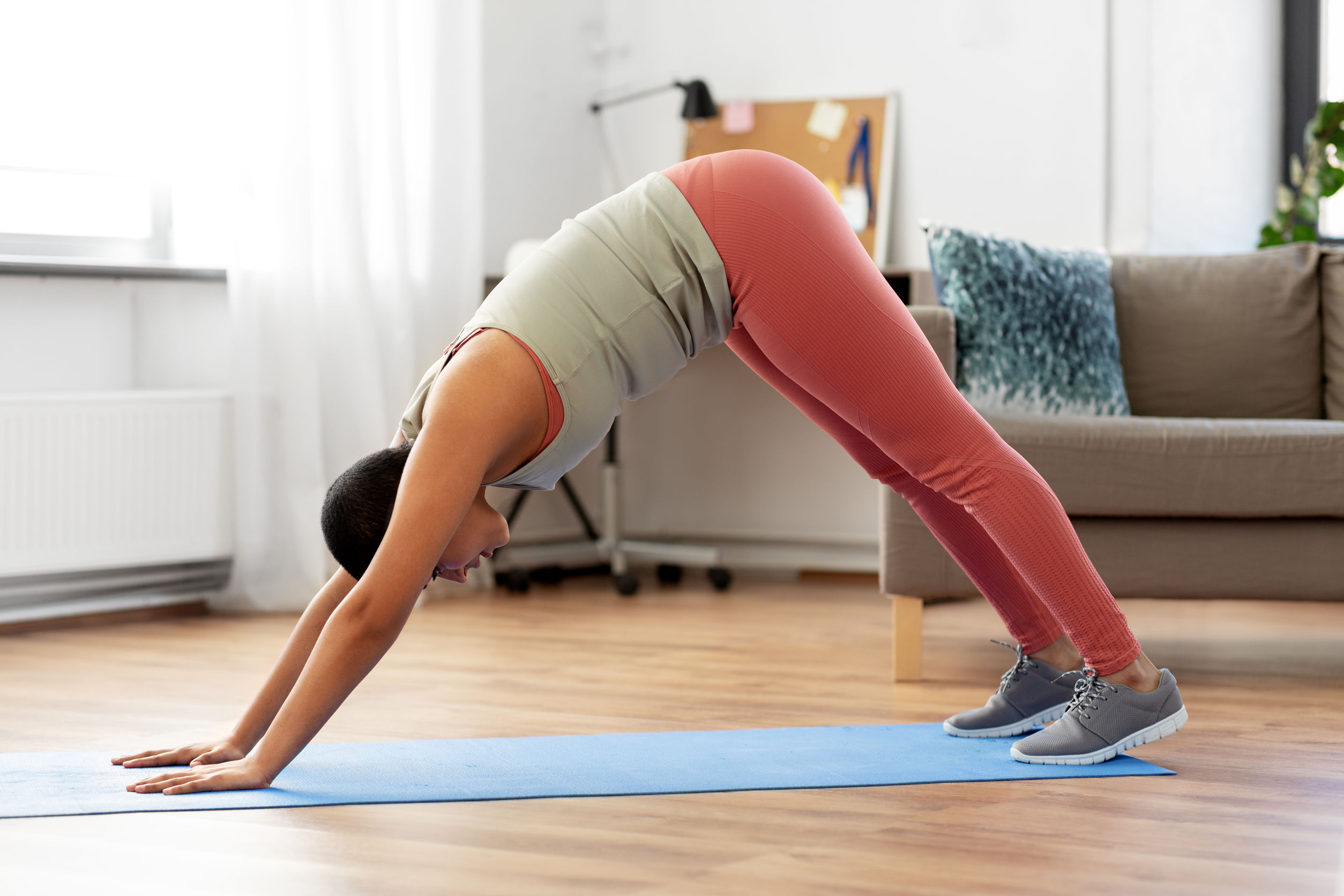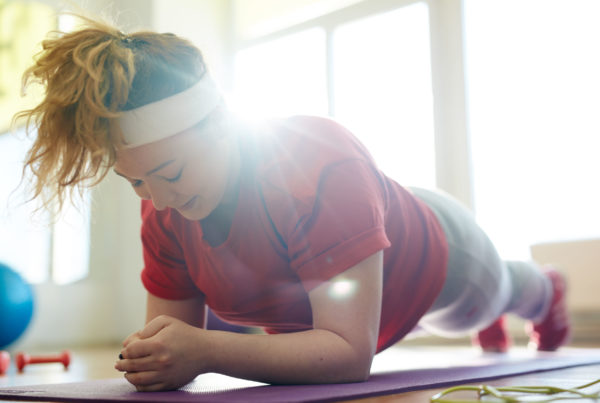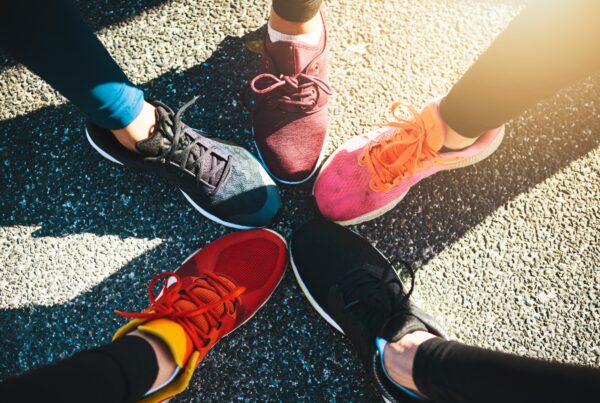”Georgia, how often do you think about your mental health? Did you know exercise can help alleviate stress and anxetiy? You can learn more in this week's article. Enjoy!
Reading time: 10 Minutes
MWi Hacks:
- Free workout programs for at home use during COVID-19
- Understand the connection between exercise and mental health and get active
MWi Summary:
- Exercise has been shown to be a powerful tool in treatment and prevention of mental health and anxiety disorders.
- When creating an at-home exercise program you can think of three categories of movements: mono structural, gymnastics, and weightlifting. Ideally, the program has variance across the movements in these categories.
- Recording your workouts and your progress has been shown to increase self-efficacy.
- Also, it is helpful to incorporate social interaction with exercise.
Let’s face it, our lives have been somewhat turned upside down over due to COVID-19. The pandemic has likely led to an increase in anxiety, both acute and chronic, due to fear of health or job loss, loss of connection to others, uncertainty, and ever-changing information. Even before the COVID-19 pandemic, mental health was a common illness amongst the United States population. The National Institute of Health reports, in 2017, nearly one in five American adults were living with a mental illness (1). It is estimated that 31% of adults in the United States will experience an anxiety disorder in their lifetime (2).
The COVID-19 pandemic resulted in prior-exercisers to either stop or minimize their activity-level, and non-exercisers to continue their sedentary behaviors. This has resulted in an increase in mental health issues, such as anxiety (3). There are a few different psychological and physiological hypotheses explaining the efficacy of exercise as an intervention (4). Exercise, both aerobic and resistance training, have been shown to be powerful tools in the treatment and prevention of mental health and anxiety disorders (5). The objective of this article to delve into the psychological hypotheses of making exercise a long-term habit, and to reap the mental health benefits of consistent activity. The three known psychological hypotheses we will discuss are: 1. Exercise promotes distraction, 2. Exercise increases self-efficacy, and 3. Exercise provides some social interaction. Understanding these psychological effects can be advantageous when setting up your own at-home exercise program. Exercising at home can help you minimize stress and feel better, provide a bridge until the reopening of commercial gyms and fitness facilities, and help provide the self-confidence and experience necessary to seek out more specific training programs.
Distraction
Distraction provides a state of presence in the moment. While exercising, you are able to focus on the task at hand. This could be a specific running pace, a timed interval, a set number of reps, or even a technical point of performance. One of the best ways to provide distraction is to offer the body a new stimulus. Too much routine can create boredom, which can possibly minimize distraction and eventually lower enjoyment. Programming different movement types, time domains, rep schemes, movement combinations, work to rest ratios, and even movement tempo can keep interest high. This describes the principle of workout variance and can easily be utilized by the novice, intermediate, and advanced exercisers.
When creating an at-home program, its best to just start with some simple variance: time, movement combinations, movement types, and rep schemes. Movements can easily be classified into 3 categories: monostructural (M), gymnastic (G), and weightlifting (W) (6). Aerobic training typically refers to monostructural movements. These are movements like running, swimming, biking, rowing, hiking, jumping rope, or even the common cardio machines found in commercial gyms. Gymnastic and weightlifting movements can be classified as resistance. Both categories create force against a load, either your bodyweight or an external weight such as a barbell, dumbbells, a kettlebell, sandbag, or bands. It is recommended to stick with functional movements (movements which engage more musculature and simulate movements used in everyday life). Functional movement require less equipment and can be performed anywhere. They also have been shown to decrease anxiety levels and increase enjoyment more than traditional resistance exercises (exercise machines and single-joint movements) (7). For examples, see table 1.
|
Note: if you do not have any of these, you can put some water bottles or jugs in a backpack. This can be utilized for almost all weighted movements. |
One of the easiest ways to simplify variance, and build a home-based exercise program, is to utilize a template. You can set how many days you want to exercise per week, set a time domain for each exercise day, and even set the number of movements and movement types. I suggest sticking to monostructural movements for your single movement days. See table 2 for an example of 3 weeks of a 3 day per week program. You can easily use this 3-week plan as a template, changing out the movements every 3 weeks. If the time domains or rep ranges are too large, scale down. As an example, the 3 days could easily be: Day 1 (5 minutes), Day 2 (10 minutes), Day 3 (15 minutes). As you progress, you can make the workouts harder by increasing the weight you use, moving faster, or even increasing the time domain.
Table 1
|
Monostructural |
Gymnastics |
Weightlifting* |
|
Running Swimming Biking Rowing Hiking Jumping rope Cardio machines |
Air squats Push-ups Pull-ups Lunges Dips Sit-ups (and variations) Planks Supermans Burpees Step-ups |
Weighted squats Weighted presses (chest and overhead) Deadlifts Power cleans Weighted lunges Weighted step-ups Bent-over rows |
*Loading can be barbell, dumbbell, kettlebell, sandbag, bands, or weighted backpack
Table 2
|
Mon |
Tues |
Wed |
Thurs |
Fri |
Sat |
Sun |
|
10 minutes GW 10 rounds of: 30 sec burpees 30 sec rest 30 front squats 30 sec rest Total work time: 10 mins Record total reps |
15 minutes MGW *AMRAP 15 minutes: 200m run 15 sit-ups 10 overhead press Record your rounds |
20 minutes M Run for 20 minutes: Alternate between 1-minutes fast 1-minute jog/walk Record distance covered |
||||
|
Mon |
Tues |
Wed |
Thurs |
Fri |
Sat |
Sun |
|
10 minutes GW AMRAP 10 minutes: 20 step ups (20-24”) 10 body rows Record total reps |
15 minutes MGW 10 rounds of: 30 sec of jump rope 30 sec rest 30 sec weighted lunges 30 sec rest 30 sec of plank 30 sec rest Total work time: 15 mins |
20 minutes M Bike for 20 minutes: Alternate between 5-minute fast 5-minute slow If you don’t have a bike, you can run, swim, or use another monostructural movement |
||||
|
Mon |
Tues |
Wed |
Thurs |
Fri |
Sat |
Sun |
|
10 minutes GW AMRAP 5 minutes: 15 Goblet squats 10 push-ups -rest 5 minutes- AMRAP 5 minutes: 15 Goblet squats 10 push-ups Record total reps for each 5 min AMRAP |
15 minutes MGW Three 5-minute rounds of: 200m run 10 power cleans Max rep sit-ups Run 200m, do 10 power cleans (barbell, DB’s, sandbag, or backpack), then do as many sit-ups as you can with the remainder of the 5 minutes. Repeat 2 more times. |
20 minutes M Run for 10 minutes -Rest 5 minutes- Run for 10 minutes |
*AMRAP=complete As Many Rounds As Possible in the given time domain.
Self-efficacy
Self-efficacy is the belief in yourself to perform a task or behavior. One agreed-upon way to increase self-efficacy is to provide mastery experiences (9). This can be accomplished by maintaining a logbook and utilizing benchmark workouts. This strategy is relevant for the novice, intermediate, and advanced exerciser. Writing down your workouts and recording your times provides a sense of accomplishment. These little victories add up and establish a higher level of confidence.
Benchmark workouts can provide feedback on improvements. Pick a handful of workouts, of different time domains, that you use for testing progress and repeat them every 2-3 months (table 3). If you’re very new to exercising, you can expect to see some pretty big improvements within a short period of time. If you have some experience under your belt, your improvements will likely be less severe. Any improvement, though, should be celebrated. Both of these mastery experience strategies can add up and provide the self-belief necessary to develop consistency, build a long-term habit, and further improve mood states.
Table 3
|
Benchmark Workout Examples |
|||
|
1000m run Record your time |
AMRAP 10 minutes 10 push-ups 15 sit-ups 20 air squats Record your rounds |
AMRAP 15 minutes 400m run 8 pull-ups (or body rows) 12 goblet squats |
6-mile Bike |
Social Interaction
Social interaction describes how people act or react with others. The key here is to utilize social interaction as a means of support or affiliation. These are interpersonal motives on the Exercise Motivation Inventory (EMI), a survey used to determine the exercise engagement motivations for different groups of people across different exercise types and programs. Social interaction is also part of a key construct of the Self Determination Theory, which is a behavior change model explaining the 3 behavioral needs necessary to maintain a behavior change (9).
Research has shown affiliation, competition, and social recognition to all be key components to exercise adherence (Feito, 2018). So, this begs the question: how do we create the necessary social interactions during these times of social isolation and social distancing?
First off, find others that are interested in starting an at-home exercise program or anyone who needs an interim program while they wait for their gym to open back up. Invite family and/or friends to come workout with you or share your workouts with them so they can perform them on their own. Either way, the idea is to have a shared experience, develop an affiliation to a small group, promote possible competition between participants, and provide social recognition (the recognition of achievement to and from others in the group).
Secondly, you can share your workouts with friend and family on social media, while providing a description of your experience. They might not be interested in joining you at first, but, after seeing your enjoyment and results, they might consider jumping in. You can provide the vicarious experience necessary to increase their self-efficacy. Similarly, you can seek others performing their own at-home workouts which can be helpful in building your own self-confidence in continuing this new endeavor.
Conclusion
We find ourselves in an interesting time where stress-levels are high, information is constantly changing, and there is a high-level of uncertainty. Exercise is a powerful tool to help minimize the effects of stress and anxiety. Exercise can be hard to initiate at any moment, and maybe more so when socially isolate or distanced. The goal with this article is to provide a starting point for exercise and some ideas on how to stay motivated. Hopefully, it is understood that this is a general program and does not take any participants strengths or weaknesses into consideration. There is no performance goal or sport-specific goal in mind. This is merely a starting point, or a bridge, to keep you moving and allow you to reap the mental benefits of exercise.
More about the Expert:
Michael Giardina is currently the Director of Education at Assault Fitness. He spent 4.5 years in the Navy before pursuing a B.S. in Exercise and Health Science and an M.S. in Applied Exercise and Health Science at Kennesaw State University. Recently, he graduated from the University of Southern California with an MPH in Epidemiology and Biostatistics. Michael has been involved in the Health, Wellness, and Fitness industry for the last 15 years, with 11 of those years spent working at CrossFit, Inc as a Course Supervisor and Content Supervisor.
https://www.instagram.com/assaultfitness_university/?hl=en
References
1. Mental Illness. (2019, February). https://www.nimh.nih.gov/health/statistics/mental-illness.shtml.
2. U.S. Department of Health and Human Services. (2017, November). Any Anxiety Disorder. National Institute of Mental Health. https://www.nimh.nih.gov/health/statistics/any-anxiety-disorder.shtml.
3. Meyer, J., Mcdowell, C., Lansing, J., Brower, C., Smith, L., Tully, M., & Herring, M. (2020). Changes in physical activity and sedentary behaviour due to the COVID-19 outbreak and associations with mental health in 3,052 US adults. https://doi.org/10.33774/coe-2020-h0b8g
4. Peluso, M. A. M., & Laura Helena Silveira Guerra De Andrade. (2005). Physical activity and mental health: the association between exercise and mood. Clinics, 60(1), 61–70. https://doi.org/10.1590/s1807-59322005000100012
5. Lebouthillier, D. M., & Asmundson, G. J. (2017). The efficacy of aerobic exercise and resistance training as transdiagnostic interventions for anxiety-related disorders and constructs: A randomized controlled trial. Journal of Anxiety Disorders, 52, 43–52. https://doi.org/10.1016/j.janxdis.2017.09.005
6. Glassman, G. (2003). A Theoretical Template for CrossFit’s Programming. https://library.crossfit.com/free/pdf/06_03_CF_Template.pdf. http://library.crossfit.com/free/pdf/06_03_CF_Template.pdf.
7. Faro, J., Wright, J. A., Hayman, L. L., Hastie, M., Gona, P. N., & Whiteley, J. A. (2019). Functional Resistance Training and Affective Response in Female College-Age Students. Medicine & Science in Sports & Exercise, 51(6), 1186–1194. https://doi.org/10.1249/mss.0000000000001895
8. Akhtar, M. (2017, April 8). What is Self-Efficacy? Bandura’s 4 Sources of Efficacy Beliefs. PositivePsychology.org.uk. http://positivepsychology.org.uk/self-efficacy-definition-bandura-meaning/.
9. Box, A. G., Feito, Y., Brown, C., & Petruzzello, S. J. (2019). Individual differences influence exercise behavior: how personality, motivation, and behavioral regulation vary among exercise mode preferences. Heliyon, 5(4). https://doi.org/10.1016/j.heliyon.2019.e01459






